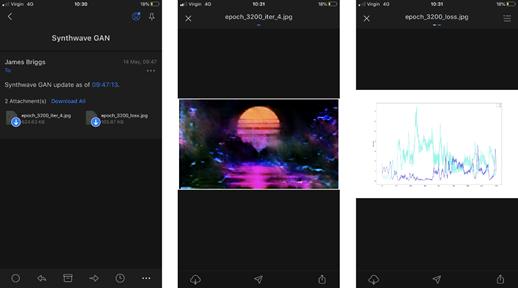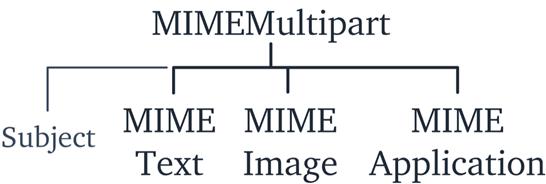一切盡在掌控之中:這個(gè)Python腳本,讓工作自動(dòng)向你匯報(bào)進(jìn)度
本文轉(zhuǎn)載自公眾號(hào)“讀芯術(shù)”(ID:AI_Discovery)
筆者經(jīng)常編寫Python腳本來(lái)進(jìn)行數(shù)據(jù)處理、數(shù)據(jù)傳輸和模型訓(xùn)練。隨著數(shù)據(jù)量和數(shù)據(jù)復(fù)雜性的增加,運(yùn)行腳本可能需要一些時(shí)間。在等待數(shù)據(jù)處理完成時(shí)可以同時(shí)做一些其他工作。
為了達(dá)到這個(gè)目的,筆者編寫了一組用于解決這個(gè)問題的Python腳本。使用這些腳本向手機(jī)發(fā)送流程更新、可視化和完成通知。當(dāng)偶爾擁有這些自由的時(shí)刻,你可以享受而不是擔(dān)心模型的進(jìn)度。
需要什么
第一個(gè)問題是,需要知道什么?這取決于你正在做的工作。對(duì)于筆者來(lái)說(shuō)主要有有三個(gè)可能會(huì)占用時(shí)間的處理任務(wù):
- 模型訓(xùn)練
- 數(shù)據(jù)處理和/或傳輸
- 金融模型
我們需要對(duì)于每一種情況具體分析。
模型訓(xùn)練
更新每n個(gè)epoch,必須包括關(guān)鍵指標(biāo)。例如,訓(xùn)練和驗(yàn)證集的損失和準(zhǔn)確性。接著完成通知,包括:
- 訓(xùn)練期間關(guān)鍵指標(biāo)的可視化(同樣,訓(xùn)練和驗(yàn)證集的損失和準(zhǔn)確性)
- 其他不太重要但仍然有用的信息,如本地模型目錄、訓(xùn)練時(shí)間、模型架構(gòu)等
- 預(yù)測(cè)輸出,對(duì)于文本生成來(lái)說(shuō)輸出生成的文本(或它的一個(gè)樣本);對(duì)于圖像生成來(lái)說(shuō),輸出結(jié)果是一個(gè)(希望)很酷的可視化
以訓(xùn)練一個(gè)神經(jīng)網(wǎng)絡(luò)來(lái)重現(xiàn)給定的藝術(shù)風(fēng)格為例。我們需要重點(diǎn)從模型中生成的圖像,損失和精度圖,當(dāng)前的訓(xùn)練時(shí)間,和一個(gè)模型的名稱。
- import notify
- START= datetime.now() # this line would be placed before modeltraining begins
- MODELNAME="SynthwaveGAN" # giving us ourmodel name
- NOTIFY=100 # so we send an update notification every100 epochs
- # for each epoch e,we would include the following code
- if e % notify_epoch ==0and e !=0:
- # here we createthe email body message
- txt = (f"{MODELNAME} update as of "
- f"{datetime.now().strftime('%H:%M:%S')}.")
- # we build theMIME message object with notify.message
- msg = notify.message(
- subject='Synthwave GAN',
- text=txt,
- img=[
- f'../visuals/{MODELNAME}/epoch_{e}_loss.png',
- f'../visuals/{MODELNAME}/epoch_{e}_iter_{i}.png'
- ]
- ) # note that weattach two images here, the loss plot and
- # ...a generated image output from our model
- notify.send(msg) # we then send the message
每隔100個(gè)epoch,就會(huì)發(fā)送一封包含上述所有內(nèi)容的電子郵件。以下是其中一封郵件:

數(shù)據(jù)處理和傳輸
這點(diǎn)不是很有趣,但在時(shí)間消耗方面,它排第一名。
以使用Python將批量數(shù)據(jù)上傳到SQLServer為例(對(duì)于沒有BULK INSERT的人)。在上傳腳本的最后,會(huì)有一個(gè)簡(jiǎn)單的消息通知上傳完成。
- import os
- import notify
- from data importSql # seehttps://jamescalam.github.io/pysqlplus/lib/data/sql.html
- dt =Sql('database123', 'server001') # setup theconnection to SQL Server
- for i, file inenumerate(os.listdir('../data/new')):
- dt.push_raw(f'../data/new/{file}') # push a file to SQL Server
- # once the upload is complete, send a notification
- # first we create the message
- msg = notify.message(
- subject='SQL Data Upload',
- text=f'Data upload complete, {i} filesuploaded.',
- )
- # send the message
- notify.send(msg)
如果偶爾拋出錯(cuò)誤,還可以添加一個(gè)try-except語(yǔ)句來(lái)捕獲錯(cuò)誤,并將其添加到一個(gè)列表中,以包含在更新和/或完成電子郵件中。
金融模型
金融建模中運(yùn)行的所有東西實(shí)際上都非常快,所以此處只能提供一個(gè)示例。
以現(xiàn)金流動(dòng)模型工具為例。現(xiàn)實(shí)中,這個(gè)過程只需要10-20秒,但現(xiàn)在假設(shè)你是華爾街炙手可熱的定量分析師,正在處理幾百萬(wàn)筆貸款。在這封電子郵件中,可能想要包含一個(gè)高級(jí)概要分析的投資組合。可以隨機(jī)選擇一些貸款,并在給定的時(shí)間段內(nèi)可視化關(guān)鍵值——給定一個(gè)小樣本來(lái)交叉檢驗(yàn)?zāi)P偷男阅堋?/p>
- end = datetime.datetime.now() # get the ending datetime
- # get the total runtime in hours:minutes:seconds
- hours,rem =divmod((end - start).seconds, 3600)
- mins,secs =divmod(rem, 60)
- runtime='{:02d}:{:02d}:{:02d}'.format(hours, mins,secs)
- # now built our message
- notify.msg(
- subject="Cashflow Model Completion",
- text=(f'{len(model.output)} loansprocessed.\n'
- f'Total runtime:{runtime}'),
- img=[
- '../vis/loan01_amortisation.png',
- '../vis/loan07_amortisation.png',
- '../vis/loan01_profit_and_loss.png',
- '../vis/loan07_profit_and_loss.png'
- ]
- )
- notify.send(msg) # and send it
代碼
上面的所有功能節(jié)選自一個(gè)名為notify.py的腳本。在示例代碼中將使用Outlook。這里需要兩個(gè)Python庫(kù),email和smtplib:
- email:用于管理電子郵件消息。有了這個(gè)庫(kù)就可以設(shè)置電子郵件消息本身,包括主題、正文和附件。
- smtplib:處理SMTP連接。簡(jiǎn)單郵件傳輸協(xié)議(SMTP)是大多數(shù)電子郵件系統(tǒng)使用的協(xié)議,允許郵件通過互聯(lián)網(wǎng)發(fā)送。
圖源:unsplash
MIME
消息本身是使用來(lái)自email模塊的MIMEMultipart對(duì)象構(gòu)建的。還需要使用三個(gè)MIME子類,并將它們附加到MIMEMultipart對(duì)象上:
- mimetext:這將包含電子郵件“有效負(fù)載”,即電子郵件正文中的文本。
- mimeimage :這是用于在電子郵件中包含圖像。
- mimeapplication:用于MIME消息應(yīng)用程序?qū)ο蟆R簿褪俏募郊?/li>
除了這些子類之外,還有其他參數(shù),比如MimeMultipart中的Subject值。所有這些加在一起就形成了下面的結(jié)構(gòu)。
把它們都放在一起會(huì)發(fā)生什么:

- import os
- from email.mime.text importMIMEText
- from email.mime.image importMIMEImage
- from email.mime.application importMIMEApplication
- from email.mime.multipart importMIMEMultipart
- defmessage(subject="PythonNotification", text="", img=None, attachment=None):
- # build messagecontents
- msg =MIMEMultipart()
- msg['Subject'] = subject # add in thesubject
- msg.attach(MIMEText(text)) # add text contents
- # check if wehave anything given in the img parameter
- if img isnotNone:
- # if we do, wewant to iterate through the images, so let's check that
- # what we haveis actually a list
- iftype(img) isnot list:
- img = [img] # if it isn't alist, make it one
- # now iteratethrough our list
- for one_img in img:
- img_data =open(one_img, 'rb').read() # read the imagebinary data
- # attach theimage data to MIMEMultipart using MIMEImage, we add
- # the givenfilename use os.basename
- msg.attach(MIMEImage(img_data, name=os.path.basename(one_img)))
- # we do the samefor attachments as we did for images
- if attachment isnotNone:
- iftype(attachment) isnot list:
- attachment = [attachment] # if it isn't a list, make it one
- for one_attachment in attachment:
- withopen(one_attachment,'rb') as f:
- # read in theattachment using MIMEApplication
- file =MIMEApplication(
- f.read(),
- name=os.path.basename(one_attachment)
- )
- # here we editthe attached file metadata
- file['Content-Disposition'] =f'attachment; filename="{os.path.basename(one_attachment)}"'
- msg.attach(file) # finally, addthe attachment to our message object
- return msg
這個(gè)腳本相當(dāng)簡(jiǎn)單。在頂部,有導(dǎo)入(這是以前介紹過的MIME部分)以及Python的os庫(kù)。
接下來(lái)定義一個(gè)名為message的函數(shù)。這允許使用不同的參數(shù)調(diào)用函數(shù)并輕松地構(gòu)建一個(gè)電子郵件消息對(duì)象。例如,可以這樣寫一封帶有多張圖片和附件的郵件:
- email_msg= message(
- text="Model processing complete,please see attached data.",
- img=['accuracy.png', 'loss.png'],
- attachments=['data_in.csv', 'data_out.csv']
- )
首先,初始化MIMEMultipart對(duì)象,并將其分配給msg;然后,使用“subject”鍵設(shè)置電子郵件主題。attach方法向MIMEMultipart對(duì)象添加不同的MIME子類。你可以使用MIMEText子類添加電子郵件正文。
對(duì)于圖像img和attachment附件,可以什么都不傳遞,只傳遞一個(gè)文件路徑,或者傳遞一組文件路徑。我們通過首先檢查參數(shù)是否為None來(lái)處理它,如果參數(shù)為None,則傳遞;否則,檢查給定的數(shù)據(jù)類型,不是一個(gè)list,就創(chuàng)建一個(gè),這就使得可以用下面的for循環(huán)來(lái)遍歷項(xiàng)。
接著,使用MIMEImage和MIMEApplication子類分別附加圖像和文件。使用os.basename從給定的文件路徑中獲取文件名,附件名包括該文件名。
圖源:unsplash
SMTP
現(xiàn)在已經(jīng)構(gòu)建好電子郵件消息對(duì)象,下一步就是發(fā)送它。這就是smtplib模塊發(fā)揮作用的地方。代碼同樣非常簡(jiǎn)單,只有一處例外。
由于直接處理不同的電子郵件供應(yīng)商和他們各自的服務(wù)器,需要不同的SMTP地址。在谷歌中輸入“outlook smtp”。不需要單擊頁(yè)面,你就可以得到服務(wù)器地址smtp-mail.outlook.com和端口號(hào)587。
當(dāng)使用smtplib.SMTP初始化SMTP對(duì)象時(shí),這兩種方法都需要用。SMTP -接近開始的send函數(shù):
- import smtplib
- import socket
- defsend(server='smtp-mail.outlook.com', port='587', msg):
- # contain followingin try-except in case of momentary network errors
- try:
- # initialiseconnection to email server, the default is Outlook
- smtp = smtplib.SMTP(server, port)
- # this is the'Extended Hello' command, essentially greeting our SMTP or ESMTP server
- smtp.ehlo()
- # this is the'Start Transport Layer Security' command, tells the server we will
- # becommunicating with TLS encryption
- smtp.starttls()
- # read email andpassword from file
- withopen('../data/email.txt', 'r') as fp:
- email = fp.read()
- withopen('../data/password.txt', 'r') as fp:
- pwd = fp.read()
- # login tooutlook server
- smtp.login(email, pwd)
- # sendnotification to self
- smtp.sendmail(email, email, msg.as_string())
- # disconnectfrom the server
- smtp.quit()
- except socket.gaierror:
- print("Network connection error, email notsent.")
smtp.ehlo()和smtp.starttls()都是SMTP命令。ehlo(擴(kuò)展Hello)本質(zhì)上是向服務(wù)器打招呼。starttls通知服務(wù)器,將使用加密傳輸級(jí)別安全(TLS)連接進(jìn)行通信。
在此之后,只需從文件中讀取電子郵件和密碼,分別存儲(chǔ)在email和pwd中。然后,使用smtp.login登錄到SMTP服務(wù)器。登錄并使用smtp.sendmail發(fā)送電子郵件。
筆者總是給自己發(fā)送通知,但在自動(dòng)報(bào)告的情況下,可能希望將電子郵件發(fā)送到其他地方。為此,我會(huì)更改destination_address: smtp.sendmail(email、destination_address、 msg.as_string)。
最后,終止會(huì)話并關(guān)閉與smtp.quit的連接。
將所有這些都放在try-except語(yǔ)句中。在瞬間網(wǎng)絡(luò)連接丟失的情況下,將無(wú)法連接到服務(wù)器。導(dǎo)致socket.gaierror。使用try-except語(yǔ)句可以防止程序在網(wǎng)絡(luò)連接失敗的情況下崩潰。
筆者將其用于ML模型培訓(xùn)更新和數(shù)據(jù)傳輸完成。如果郵件沒有被發(fā)送,那也沒有關(guān)系。這種簡(jiǎn)單、被動(dòng)地處理連接丟失是合適的。
放在一起
圖源:unsplash
現(xiàn)在已經(jīng)寫了代碼的兩部分,我們就可以發(fā)送電子郵件了:
- # builda message object
- msg = message(text="See attached!", img='important.png',
- attachment='data.csv')send(msg) #send the email (defaults to Outlook)
這是所有的電子郵件通知和/或使用Python的自動(dòng)化的全過程。感謝email和smptlib庫(kù),設(shè)置過程變得非常容易。

還有一點(diǎn)請(qǐng)注意,公共電子郵件提供程序服務(wù)器地址和TLS端口。
對(duì)于任何耗費(fèi)大量時(shí)間的處理或訓(xùn)練任務(wù),進(jìn)度更新和完成通知通常才是真正的解放。Python,讓工作更美好!






























